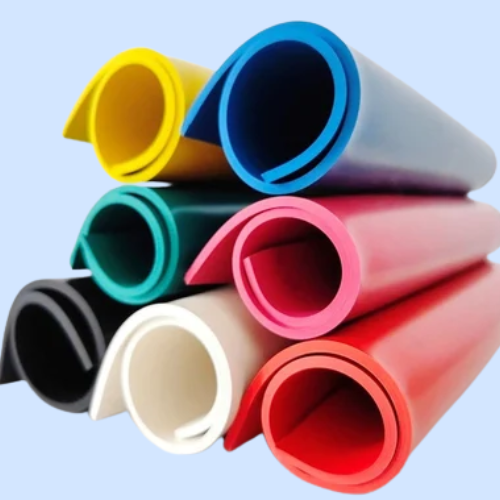What is a Silicon Rubber Gasket Sheet
Silicone rubber gasket sheets are used in many industries because they work well in tough conditions. They can handle very high and low temperatures, resist UV rays and ozone, and stay flexible for a long time. In the UAE and in the Middle East region, they are common in manufacturing, food processing, electronics, and healthcare.
Silicone rubber gasket sheets can last longer, which means fewer replacements and lower maintenance costs. Choosing the right grade makes them safe for contact with food, chemicals, or delicate equipment, making them a practical and reliable choice for different industrial needs.
Features
Silicone gasket sheets stand out because of several unique, performance-enhancing features:
Silicone maintains its flexibility and sealing ability in freezing temperatures and extreme heat, making it ideal for the UAE’s diverse climate and specialized industrial environments like ovens, freezers, and outdoor enclosures.
- Outstanding Weather Resistance
They resist damage from prolonged sun exposure, ozone in the air, and changing humidity levels, properties that keep them functioning effectively outdoors without cracking or hardening.
- Electrical Insulation Properties
Silicone sheets prevent electrical leakage, making them safe to use in electrical enclosures and equipment where insulation is critical.
- Excellent Release Properties
They do not stick easily to other surfaces, which allows smooth handling, problem-free removal, and easy replacement in maintenance work.
- Biocompatibility & Safety for Sensitive Use
FDA-approved grades are non-toxic, odorless, and resistant to bacterial growth, making them suitable for food processing, medical devices, and pharmaceutical use.
When silicone sheets are pressed for a long period of time, they can return to their original shape, which helps to create a strong and long-lasting seal.
Applications
In the UAE, silicone rubber gasket sheets are used across diverse industries thanks to their durability and adaptability. They are used for sealing and gasketing inside chemical tanks, HVAC units, low-temperature storage, and outdoor equipment enclosures, where they provide dependable sealing against temperature fluctuations, moisture, and environmental exposure. Their electrical insulation capacity makes them ideal protection linings for non-critical electrical applications. In cushioning and padding roles, they work in vibration and shock-absorption systems, such as in machinery mounts or HVAC ducts.
They also serve as spacers and functional components in non-food machinery, packaging systems, and light-load equipment. The pharmaceutical and laboratory sectors rely on silicone sheets for their resistance to contamination and ability to withstand sterilization processes. At the same time, food industry users prefer FDA-approved grades for contact surfaces in processing lines where hygiene and material safety are critical.
How to Use Silicon Rubber Gasket Sheet?
Proper selection, careful handling, and regular inspection are required to effectively use silicone rubber gasket sheets. Follow the steps below to properly use Silicone Rubber Gasket Sheets.
Select the right grade for your application: FDA-approved for food, high-temperature for ovens, or medical-grade for healthcare use.
- Select the correct thickness and hardness to match the sealing environments.
- Always clean and dry all the surfaces before the installation for proper joining and sealing.
- Don’t overstretch or compress to avoid premature damage at the time of installation.
- Work in a well-ventilated area when adhesives or sealants are used.
Safety Guidelines
Silicone rubber gasket sheets are usually safe to use, but following these safety guidelines helps maintain the quality and workplace safety.
- Use gloves to avoid contact contamination and safety glasses to protect against accidental splashes or airborne particles from cutting.
- Remove old gasket residues, grease, or dirt before fitting the new sheet.
- Do not overstretch or compress beyond recommended limits; this prevents permanent deformation.
- Ensure adequate airflow when applying adhesives or sealants to reduce inhalation of fumes.
- Do not exceed operational temperature ratings to avoid material breakdown.
- Ensure silicone grade matches the contact chemicals; avoid direct exposure to strong acids or hydrocarbons unless using fluorosilicone.
- Check for wear signs like hardening or cracking and replace when needed.
- Keep in a cool, dry area away from sunlight and heavy loads.

